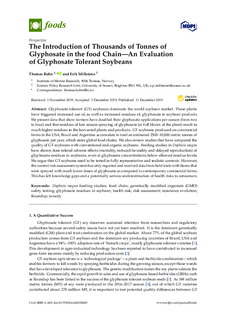The Introduction of thousands of tonnes of glyphosate in the food chain - an evaluation of glyphosate tolerant soybeans
Journal article, Peer reviewed
Published version
Permanent lenke
http://hdl.handle.net/11250/2640193Utgivelsesdato
2019Metadata
Vis full innførselSamlinger
- Articles [3012]
- Publikasjoner fra CRIStin [3070]
Sammendrag
Glyphosate-tolerant (GT) soybeans dominate the world soybean market. These plants have triggered increased use of, as well as increased residues of, glyphosate in soybean products. We present data that show farmers have doubled their glyphosate applications per season (from two to four) and that residues of late season spraying of glyphosate (at full bloom of the plant) result in much higher residues in the harvested plants and products. GT soybeans produced on commercial farms in the USA, Brazil and Argentina accumulate in total an estimated 2500–10,000 metric tonnes of glyphosate per year, which enter global food chains. We also review studies that have compared the quality of GT soybeans with conventional and organic soybeans. Feeding studies in Daphnia magna have shown dose-related adverse effects (mortality, reduced fecundity and delayed reproduction) of glyphosate residues in soybeans, even at glyphosate concentrations below allowed residue levels. We argue that GT soybeans need to be tested in fully representative and realistic contexts. However, the current risk assessment system has only required and received data from field trials with beans that were sprayed with much lower doses of glyphosate as compared to contemporary commercial farms. This has left knowledge gaps and a potentially serious underestimation of health risks to consumers.
